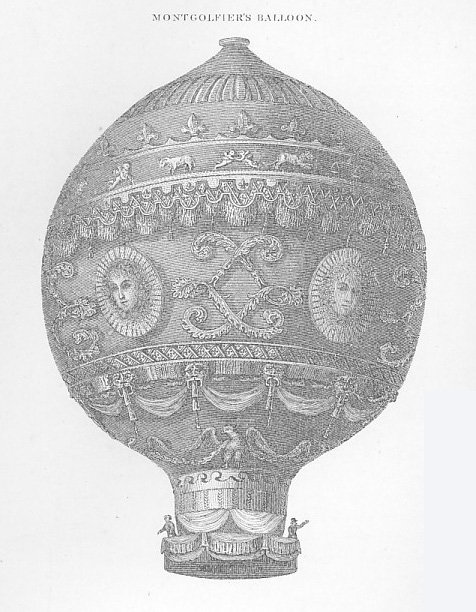1902 Encyclopedia > Aeronautics > Discovery of the Balloon: the Brothers Montgolfier
Aeronautics
(Part 8)
Discovery of the Balloon: the Brothers Montgolfier
We now come to the discovery of the balloon, which was due to Stephen and Joseph Montgolfier, sons of Peter Montgolfier, a large and celebrated papermaker at Annonay, a town about 40 miles Lyons. The brothers had observed the suspension of clouds in the atmosphere, and it occurred to them that if they could enclose any vapour of the nature of a cloud in a large and very light bag, it might rise and carry the bag with it into the air. They accordingly made experiments, inflating bags with smoke from a fire placed underneath, and found either that the smoke or some vapour emitted from the fire did ascend and carry the bag with it.

Balloon of the Montgolfier Brothers
Being thus assured of the correctness of their views, they determined to have a public ascent of a balloon on a large scale. They accordingly invited the States of Vivarais, then assembled, at Annonay, to witness their aerostatic experiment; and on June 5, 1783, in the presence of a considerable concourse of spectators, a linen globe of 105 feet in circumstance was inflated over a fire fed with small bundles of chopped straw, and when released rapidly rose to a great height, and descended, at the expiration of ten minutes, at the distance of about 1 1/2 mile. This was the discovery of the balloon. The brothers Montgolfier imagined that the bag rose because of the levity of the smoke or other vapour given forth by the burning straw; and it was not till some time later that it was recognized that the ascending power was due merely to the lightness of heated air compared to an equal volume of air at a lower temperature. Air, like all other fluids, expands by heat, and thereby becomes rarefied, so that any volume of hot air weights less than the corresponding volume of air at a lower temperature. If, then, the air inside the balloon be so heated that it, together with the balloons, weights less than the air displaced, the balloon will rise till it arrives at such a height that it and the enclosed air are equal in weight to that of the displaced air, when equilibrium will be obtained. In Montgolfier's first balloon, no source of heat was taken up with it, so that the air inside rapidly cooled and the balloon soon descend.
Read the rest of this article:
Aeronautics - Table of Contents
|
